

Berkeley: University of California Press, 2001. Revised edition, 822 pp.
| California Water |  |
|
| Norris Hundley, Jr. |  |
|
| The Great Thirst, Californians
and Water: A History. Berkeley: University of California Press, 2001. Revised edition, 822 pp. |
||
"...water issues are so closely intertwined with the core elements of California's (and the American West's) political, economic, legal and cultural evolution."
(p. xvii)
This historical explanation of water, mineral, agricultural, and urban resourcedevelopment based on a descriptive and comparative approaches analytically conveys the depths of recurrent controversies and the complexities behind the myths of modern market economies and capital formation. Instead of "rugged individualism," Hundley makes it obvious that hydraulic institutions that were created in the arid and land poor western states enabled societies to inhabit desert lands of little or no use to farming and urban life without irrigation and extensive aqueduct building.
Themes are:
"dynamic interplay between human values and what human
beings do to the waterscape."
"I begin looking at California as a natural environment, before the Europeans arrived, and at how Native American viewed the environmental as something to be manipulated, yet always within the context of maintaining their symbiotic relationship with nature."
That attitude changed with the gold rush. "Imbued with a spirited individualism."
"California's emergence as a collection of water seekers."
"Providing abundant clear water to multitudes of people who expressly wanted that to be done."
xviii - xix
° Another theme is how crucial government . . . . has been in shaping water policy and use."xix° Still another theme is the close interrelationship between private and government interests."xix° "The relationship between American political culture and California water policy -- constitutes another theme."
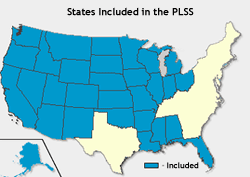 Public land survey states from which the Public Domain was created; half og California reamins in federal hands as part of the Public Domain.
Public land survey states from which the Public Domain was created; half og California reamins in federal hands as part of the Public Domain.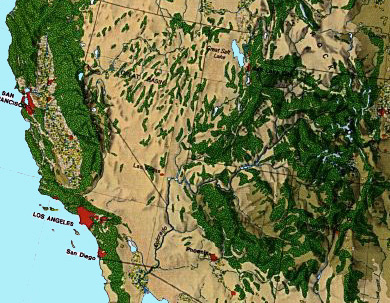 In this map of the southern far west, red indicates urban metropolitan areas, green indicates arable or forested land, & brown indicates semi-arid or desert conditions.
In this map of the southern far west, red indicates urban metropolitan areas, green indicates arable or forested land, & brown indicates semi-arid or desert conditions.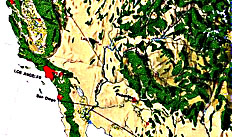
"The lack of informed and consistent leadership at the highest levels in Sacramento and Washington has not augured well for a state whose population continues to grow at a pace unmatched in the national experience."
 Table
of Contents
Table
of Contents 1 The Aboriginal Waterscape Manipulation and Near Harmony,
2 Hispanic Patterns: Community and Authority,
3 The American Takeover: Laissez-faire, Localism & Monopoly,
4 Urban Imperialism: A Tale of Two Cities,
5 Hydraulic Society Triumphant: The Great Projects,
6 Hydraulic Society on the Defensive
7 Water Policy at the Crossroads
8 Reflections
| Themes | Contents | Chronology | Conclusions | Map | Water Law
Lead off phrases of each Chapter are in bold type:

Sequoia gigantea, a Sequoia tree in the National Park of the same name.
Tree ring analysis suggests a periodic recurrence of drought in of the past with respect to growth and senescence intervals.
When did the changes occur?
892 - 1112: began and ended a 220 year period of extremely dry (drought) conditions.
wet (extreme rainfall) conditions.
1209 - 1350: began and ended another period of extremely dry (drought) conditions.
1500s - 16th century "a megadrought, the most widespread, severe and prolonged in the last two" millennia.
1600- 1625: dry period ("lengthy periods of deficient precipitation")
1720 - 1730: dry period
1760 - 1890: Third driest period of drought conditions.
1769 - 1821: Spanish Colonial Period
1821 - 1846: Mexican Independence Period
1865 - 1885: dry period
1928 - 1934: dry period
1935 - 1944: wet (extreme rainfall) conditions.
1976 - 1980: dry period despite a 1976 El Nino winter.
1983 - 1984: wet El Nino winter
1987 - 1992: dry period
2007 - 2012 serious and widespread drought condition caused Lake Meade's lowest ever levels
Chapter 1
The Aboriginal Waterscape: Manipulation and Near Harmony
"Once it was a far different place. Aboriginal California,
with 275,000 to 300,000 residents by current reckoning was among the most densely
populated areas in North America."
Agricultural and Cultural Patterns
"Native Californians did not live, however, in complete harmony with nature, nor did they refrain from any significant manipulation of the environment."
p. 4
The Waterscape
"the waterscape of aboriginal California differed markedly from that of today."
"They supported an abundance of fish, game and waterfowl as well as beaver and otter. Cattails, tules, willows and sometimes alder dominated freshwater marshes inhabited by ducks swans, marsh wrens, rails, and geese that darkened the sky with their enormous numbers."
"The labyrinthine waterways of the delta, whence the two rivers made their way to San Francisco Bay and the Pacific Ocean."
p. 5
65% of the precipitation evaporates.
Leaving behind:
71 million acre feet to flow as runoff to the rivers and estuaries.
450 aquifers held groundwater at different depths depending on geology:
1.3 billion acre feet capacity originally
.85 billion acre feet remain due to pumping of groundwater
pp. 8-9
"Of the ground and surface water..., agriculture uses 77 percent (28 million acre feet) and cities 23 percent (8.5 million acre feet)."( 1990s )
"The source of all this water is the Pacific Ocean."
p. 9
"erratic precipitation patterns."
Average in Los Angeles for example are deceptively unrevealing of the pattern:
Average rainfall is 15" annually; but one period was characterized by 19", 6", 11", 14", 40", & 11".
p. 10
Waterways and Lifeways
".. the Indians ....were successful enough to make California one of the most densely populated areas north of Mexico."
"Water played the most significant role in village location. Unlike peoples who frequently established rivers as boundaries, California natives looked upon the entire watershed of streams, reaching back from both banks, as natural territories."
Fisheries: steel head (sea going rainbow trout), king salmon, and four other species of ocean going freshwater fish, link many forests to the sea.
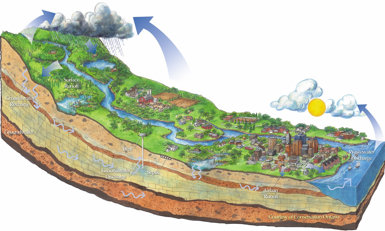 The entire watershed [pictured here] is often the sustaining influence in settlement, be that migrating, grazing, farmland or homesteads, leading to urban, or extended metropolitan areas.
The entire watershed [pictured here] is often the sustaining influence in settlement, be that migrating, grazing, farmland or homesteads, leading to urban, or extended metropolitan areas."freshwater was crucial,...In the preparation of acorns, the principle vegetable food of most California natives."
p. 16
"Resource management also entailed manipulating the physical environment."
In the "managed use of fire."
p.17
Agriculture and cultural patterns
Basket making required the selection of certain plants whose spread depended on fire or water control
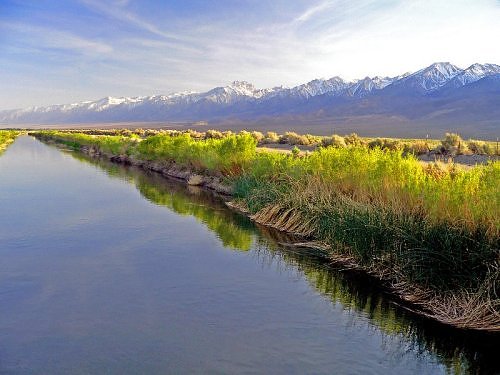 Water borders sustain certain kinds of plants perfect for making baskets and these thrive today along the Owen's Valley canal.
Water borders sustain certain kinds of plants perfect for making baskets and these thrive today along the Owen's Valley canal."Agriculture, and particularly irrigation agriculture, was being practiced long before the arrival of the Europeans."
p.18
The Paiute sometime around 1000 AD "constructed and elaborate irrigation system."
"agriculture developed independently" in the Owens Valley "they built a dam on Bishop Creek and diverted water several miles
p.19
Population growth as an alleged trigger for the adoption of agriculture:
As the drought in the west grew in its influence migration prompted and increase in the density of the Owens Valley.
Hints of this in a "decline of nomadism and a rise in permanent villages."
p. 20
Colorado River Valley cultivation of corn, melon and black-eyed beans reveals a Hohokam (Arizona & Southwest) influence. 63% of the desert populations were sustained by the Colorado River's alluvial agricultural system (flood enriched)
p. 21
Symbiosis and Community
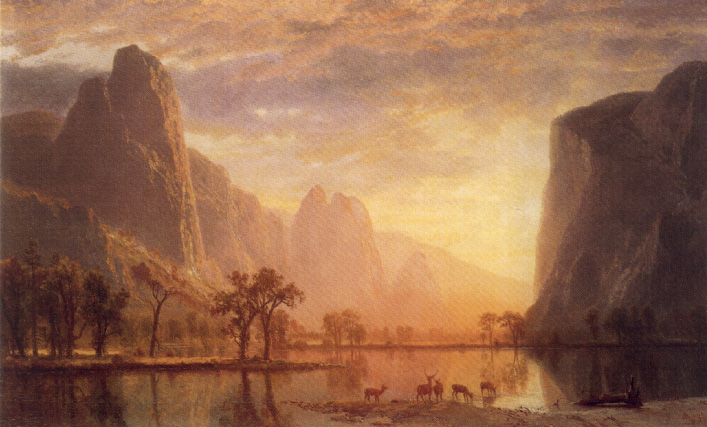 The Sierrra Nevada Mts. in Yosemite Valley, by Albert Bierstadt, 1864.
The Sierrra Nevada Mts. in Yosemite Valley, by Albert Bierstadt, 1864."Still another feature in counterpoint with the future was the absence among the Indians of a private property right in the use of water that could be bartered or sold."
p. 25
Old Wintu woman relates the Wintu belief of water that "I am awfully smart"
"..,but I came from the ocean and I shall go back into the ocean. You can dig a ditch an put me in it, but I go only so far and I am out of sight. I am awfully smart. When I am out of sight I am on my way home."
p. 25
Chapter 2
Hispanic Patterns: Community and Authority
Spain's settlement of Alta California in 1769 introduced a
lifestyle and a value system at sharp variance with those of native peoples
of this most distant of the empire's northern possessions."
"Apportion Water justly and fairly "
Lessons in Survival
Misjudgments
Royal Authority and Community Rights
Community Obligations
Community Rights and Private Rights
When Rights Collide: Bien Procumunal
The Darker Side
"most newcomers..., were themselves Indians" (from Mexico) who accompanied the Spanish conquistadors.
"conviction that nature was a divine gift" for human use
p. 28
"Apportion Water justly and fair."
Spanish attitudes were shaped by Greek and Roman laws and Judeo-Christian interpretations that stressed instrumental beliefs that nature is unproductive without humans completing an unfinished creation
Water was of such fundamental importance that its lavish display became synonymous with wealth, power, and technological sophistication. Fountains emerged as commonplace symbols of achievement."
p. 29
"The fundamental water-use unit in Spain was the local irrigation community where customs and laws had evolved over generations, drawing heavily on earlier Roman, Germanic, and Arabic experience."
"necessity sometimes blurred the distinction between public and private."
p. 30
Four communal arrangements emerged on the California frontier
| the fort | the mission | the town | the rancho |
| Presidio | Franciscan | Pueblo | Encomienda |
| San Diego, 1769 | San Jose, 1777 | ||
| Monterey, 1770 | Los Angeles, 1781 | ||
| San Francisco, 1776 | Branciforte, 1797 | ||
| Santa Barbara, 1782 |
10.4 miles squared |
"There was … no water." Juan Gaspar de Portolá
p. 32
21 Franciscan missions were established over 54 years became the most widespread Hispanic institution in California.
"all the lands should be ascertained which can have the benefit of irrigation" in the establishing of Los Angeles
"too much water could be as serious a problem as too little."
p. 36
Branciforte failed after 1800s from lack of sufficient water to sustain agriculture, grazing only was possible.
"We have ordered that the pastures, woods, and waters be in common in the Indies," 1541 royal declaration
usufructuary, for the sole use or procurement of the tenant
"Under Spanish law, water in a municipality did not belong to separate individuals, but rather passed from the monarch to the entire community as a corporate body."
39-40
Plan of Pitic ( Hermisillo, Mexico); the town's water would be shared by all residents
41
Chapter 3
The American Takeover: Laissez Faire, Localism, and Monopoly.
"The conquest of California by the United States in 1846 and the discovery of gold two years later ushered in a sequence of events that profoundly altered the vast new American acquisition."
The Gold Rush (1848-49) changed just about everything including the relation of water to land and power.
"The population boomed from some 10,000 non Indians in 1846, to 100,000 three years later, to nearly 1-5 million by 1900."
"First in Time, First in Right" (prior appropriation doctrine)
Hydraulicking and Environmental Destruction
Monopoly and a Clash of Rights
Lux vs Haggin and the California Doctrine
The Irrigation District and the persistence of monopoly
Localism and the Search for Alternatives
The Rainmakers
The Progressive Impulse: from laissez faire to Centralized Planning
Toward the Reclamation Act (1902)
American Political Culture
"Localism and laissez faire were the Democrat's political shibboleths."
p. 68
Contest of ideologies on the high Sierra frontier:
| Thomas Jefferson & Andrew Jackson | Alexander Hamilton & Henry Clay |
| states rights | federal authority |
| "laissez faire" | "American System" |
| Preemption Act, 1841: "first in time, first in right" | Swamplands, Homestead & Pacific Railway Acts |
pp. 69 - 70.
"First in Time, First in Right" (prior appropriation doctrine)
Water diversion necessitated by gold bearing lodes and seasonal aridity of the region.
Gold was discovered on federal land; that is land not yet surveyed and passed into settler's hands.
Law of the mining camp's precedent lead to the "doctrine of prior appropriation."
p. 73
1866 Congress endorsed the right of prior appropriation and with it State Rights to regulate water use.
Congress set a precedent in mining that applied to agricultural and manufacturing use of water.
"Thus the new law, as it emerged in nineteenth-century California, ratified the survival instincts of a profit-driven people in an arid land. It endorsed swift commandeering of water resources and rapid economic development, and it gave no advantages to communities over individuals, though towns and cities could condemn rights that individuals had acquired."
" encouraged individual and corporate tendencies to monopolize as much of it (water) as possible."
p. 75
Water Law in the US is different in the arid west from the more humid east.
| Western Law | Eastern Law |
| prior appropriation | riparian right |
| the first to use and keep using water has inalienable access | property adjacent to water may use it |
| created in the mining camps (1848-49) and upheld by the courts | established by State legislative action in 1850s |
Hydraulicking and Environmental Destruction
placer deposits were exhausted within several seasons
Some firms profited so well in supplying water to the new enterprises that they avoided mining altogether and devoted their energies to acquiring water rights and selling the precious commodity."
pp. 75-76
In 1855 the State Supreme Court upheld the right of companies to retail water not directly connected to mining.
Ironically individualism led to corporate take over of streams and water sources.
"Among the most profitable of the new entrepreneurial ventures was hydraulic mining, a California invention that... spread .. like the plague...."
p. 76
destruction was extraordinary and the profits were three to one and the spread of the industry required technical engineering prowess and hydraulic principles that were later used in larger private and public water projects around the west.
p. 77
3 times the water consumed by San Francisco at the time (1880s) was diverted into hydraulic mining.
p. 78
Rivers silted up and the bed of the Sacramento River and its tributaries rose increasing the flooding by destroying first natural and then constructed levees. Thousands of acres of farmlands, orchards and fields were destroyed.
Failure of the laissez faire dominated state legislature to control the industry
by 1884, the US Circuit Court of Appeals based on nuisance and damages ruled against the mining industry in favor of the farmers -- shutting down hydraulic mining-- for destroying the navigability of the Feather and Sacramento Rivers.
"...Corporate desires to seize water and blast away at the landscape in a frenzied quest for riches."
p. 79
The Politics of Flood Control
Sacramento Valley was a forty (40 by 150 ) one hundred and fifty mile long flood prone basin of largely swampland.
In 1850 the states were deeded all swamp and overflowed lands on the condition that they be reclaimed by levees and drained for agriculture.
State Board of Swampland Commissioners, created as an extra-Executive authority elected by the Legislature to create a statewide plan for the entire valley.
p. 81
To levy taxes for reclamation the SBSC created the swampland (or later) reclamation district
1868, the legislature rescinded the SBWC and replaced it with local control and weak centralization of the engineering specs.
"a return to the earlier practice of atomized protective systems, with only the largest (and most expensive) levees of the wealthy affording some semblance of security."
"Thus , laissez-faire, localism, and monopoly became standard practice in flood-control planning just as they had in the allocation of water for mining."
p. 84
Riparian Rights
"no one could acquire a property right to the corpus of the water itself,"
"Location alone determined the right, which simply resided in the ownership of land bordering the stream."
p. 85
Two competing water systems grew up in California:
prior appropriation in the gold fields
English Common Law and riparian rights by Legislative adoption in 1850.
Both approaches were used and codified in the Civil Code in 1872.
Though riparian rights prohibited diversion for irrigation, courts allowed limited diversion to assist (1865) irrigation. Therein lay the seeds for future clash of interests and conflict over use of water.
Pp. 86-87
"For most ranchers, riparianism became the doctrine of choice since it assured them a continuous flow of water for their livestock and periodic flooding of bottomlands for the growing of alfalfa and hay.
p. 89
As irrigated specialty crops spread, demand for water and sources for water grew straining the doctrine of riparian rights.
60,000 acres irrigated in 1870, to 300,000 acres in 1880,, 1 million acres in 1890.
Ranchers opposed upstream diversions basing their insistence on riparian rights.
Throughout the 1870s and 1880s a "groundswell of popular opposition to riparianism"
p. 93
Lux Vs Haggin and the California Doctrine

1879 - 1886 two large land owners squared off in court over the clash of water right systems.
This "State Supreme Court ruling saddled California with a new system of water law but failed to alter the pattern of land and water rights concentrated in relatively few hands."
James Ben Ali Haggin and the purchase of Kern County land to the amount of 400,000 acres for irrigation.
Henry Miller and Charles Lux
At the alluvial deposits of the Kern River these two giants in accumulating lands confronted one another.
Haggin was the upstream owner diverting water for irrigation away from the downstream ranchos of Miller and Lux.
Drought of 1877 placed Miller and Lux at a serious disadvantage when the Kern River ran dry.
May 1879, having been denied a fourth of the water of the Kern River water Miller took Haggin to court.
Lower courts ruled for prior appropriation, while Miller appealed to the State Supreme Court.
SSC ruled in favor of riparianism in a qualified sense: hybridism of the California Doctrine.
Prior appropriation can supersede riparian rights when and only if the prior appropriator is actually using the water before the downstream riparian owner had acquired the property and as the riparian owner began to use the water.
"Put simply, both systems were legitimate and timing determined which prevailed in a conflict."
p. 97.
The Irrigation District and the persistence of monopoly
Hampered by law the irrigationists were equally confronted with a hostile or at least unpredictable climate, rainfall came at the wrong season and delivered far more water than was needed when it did come.
"The real enemy was monopoly, whether by riparians or appropriationists."
p, 99
The obstacle now was to perfect some means of securing small holders access to water
In response to the decision in the Miller & Haggin case in an attempt to secure water and land for small holders the Legislature passed the Wright Act in 1887.
the Wright Act gave irrigation districts the legal authority to condemn property to obtain sufficient water.
p. 100
"In some ways the irrigation district was reminiscent of Hispanic institutions."
14,000 farmers irrigated lands by 1890s
p. 101.
New pumps made deep groundwater available in 1890s.
p. 101
1857, Crandall vs. Woods, incorporated the idea of "adverse prescription"
"The gains were more illusory than real. The Wright Act proved a limited success at best."
"Moreover, most of the agricultural land (62 percent of it) remained in large ownerships exceeding a thousand acres."
Pp. 102 -103.
By the 1890s in California, however, the irrigation district concept, which had been introduced with such enthusiasm only a few years earlier, was largely a failure – until it was revived and reformed in the early twentieth century."
p. 103.
"an innovation known as the mutual water company"
1857, the Anaheim Water Company was formed with land holdings amounting to 1200 acres.
p. 104.
George Chaffey was the preeminent promoter of mutual water companies and the holding of water rights in condominium among the land owners of the corporate area. He promoted Etiwanda, Ontario and Whittier. Where he used hydroelectricity for lighting streets.
Successes brought international attention and Chaffey went to Australia.
p. 107
Severe drought struck at the end of the century.
"many gave way to an irrational return to ancient superstitions."
Charles Hatfield –the nation's most renowned "rain maker" – [a person who claimed to be able to cause sufficient rainfall.]
December 1915, he promised San Diego rain in exchange for $100,000 just before the onset of a torrential season.
p. 112.
The Progressive Impulse: from laissez faire to Centralized Planning
1878, John Wesley Powell's, Report on the Arid Regions
Panic of 1893 and ensuing depression brought populist and progressive calls for reform
Calls for a regional reclamation effort to create small scale Jeffersonianism in the agrarian west.
Chapter 4
Urban Imperialism: A Tale of Two Cities
"Cities dominate modern California just as they do much
of the nation and the world. In California, community living in villages, towns,
and eventually vast metropolitan areas has almost always been the norm."
Los Angeles: from Hispanic Village to American City
San Francisco: An instant city with an Instant Water Problem
Hetch Hetchy Predicaments
Toward a Utilitarian Triumph
The Ironies of Victory
A Comparison of Two Cities
"By the 1890s, San Francisco and Los Angeles were in vanguard
of western cities that were searching for additional 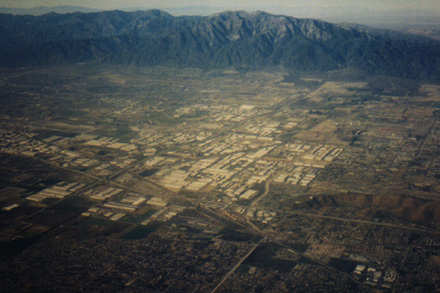 water
sources.
water
sources.
"From about 1,600 residents at the time of statehood (1850), Los Angeles jumped to 100,000 by century's end, and then during the second decade of the nineteenth century bypassed San Francisco to become the state's most populous city."
"boosterism"... "viewed growth as an end in itself and water as the chief means of sustaining it."
from Hispanic Village to American City
Los Angeles bested San Francisco "in both imagination and aggressiveness in pioneering the new imperialism..."
Los Angeles as a town chartered by the state Legislature after State hood inherited all of the rights to water granted it by Mexico and Spain when LA was established as a pueblo.
Thus it "continued to directly control the community's water system" The Town council established a zanjero to " issue permits and collect water taxes and maintained a labor force of Indians to maintain aqueducts, wells and canals.
p. 123
" water remained the acknowledged means of sustaining the new prosperity (based on commerce) as it had the old (agriculture)."
p. 124
Los Angeles Population growth:
1860 -------- 4,300
1870 ------- 13,000
1880 ------- 50,000
Completion of the railroad from Chicago tied Los Angeles to the southcentral United States via Santa Fe and Texas which also allowed fresh fruit in refrigerated cars to reach more people and extend the produce into larger urban markets.
p. 124
Smallpox epidemic of 1863 raised the need for sanitation on the civic agenda.
Water companies were believed the best means of securing an urban water supply to the city, at first.
Upstream diversions of water flowing into the city began to worry municipal fathers in 1870s
Legerdemain and Pueblo Water Right
the city went to court to seek an injunction to stop upstream users from diverting water
Rancho Los Feliz, north and below the mountains, was the city's initial target whose owner was then Leon Baldwin who irrigated his orchards from the middle -- upper reach of the Los Angeles River.
John Godfrey was the persuasive and imaginative City Attorney who handled the case
The pueblo was from its creation, he insisted, sole legal grantee of all the water in the Los Angeles River and under the Treaty of Guadeloupe Hidalgo had to be respected by subsequent American law.
"the owner of … all the water flowing in … [the] river." A most audacious claim at best.
p. 130
In 1874, the Legislature gave the city exclusive right to all the water in the river.
Baldwin argued that by riparian right and adverse prescription (had been using the river without objection by Los Angeles) the water was there for his use.
In 1879 the State Supreme Court ruled against the city
p. 132
In 1885 the city paid $50,000 for the Los Feliz Rancho to John Baldwin for the water diversion rights.
In 1881 in another case Feliz vs. Los Angeles the State Supreme Court ruled that Los Angeles had the right to remove diversion works of other owners on the Los Felix Rancho.
p. 133
Without resort to Spanish and Mexican law the SCC decided the case to favor the Los Angeles control of the river's water, but with an enormous restriction on how the city can use excess water so long as it does not damage downstream users.
p. 134
1895, Vernon Irrigation Co. v. Los Angeles, Vernon's lawyers ignored the pueblo water right as dismissed by the Baldwin case, and thus failed to effectively challenge the city's claim.
p. 135
SSC addressed the Pueblo rights question, the "pueblo water right could be asserted only to the amount needed to supply the wants of the inhabitants."
p. 136
"The judges in Vernon were less interested in Spanish legal reality than in what the Los Angeles city council, the state legislature, and now they affirmed should exist: a pueblo water right allowing Los Angeles to become a great city."
p. 137
In 1899 the Court extended the Pueblo right was extended to areas annexed to Los Angeles after incorporation as a pueblo of four square leagues (twenty-seven square miles). Annexation thus became a means of securing more water.
p. 139
Girding for expansion
Los Angeles City Water given control over the supply in 1868 until 1898.
In 1903 the city residents voted to create a municipal commission to control the water. Five member Board of Water Commissioners
p. 140
"rights to all the water of the Los Angeles River basin" Yet by 1904, William Mulholland, the Superintendent of the new Commission voiced concern the river was insufficient to meet the growing cities' and suburb's increasing per capita demands
The Owens Valley Caper
The Bureau of Reclamation was established in 1902 by Congress to bring needed irrigation water to arid lands in the west; with a mission on public lands to facilitate the needed dams, reservoirs and aqueducts to fulfill that mission of irrigating desert lands.
235 miles north of the city in the Eastern Sierra was the Owen's Valley
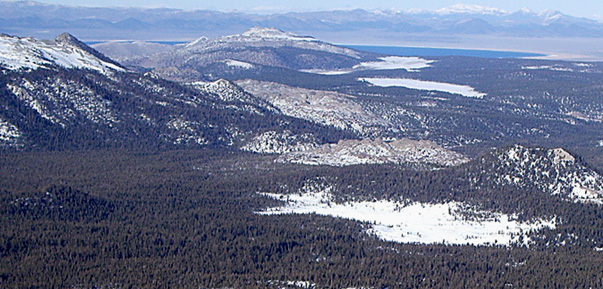 Mono Lake in the upper background from Mammoth Mountain in the Eastern Sierra Nevada range looking from west to east towards the White Mountains.
Mono Lake in the upper background from Mammoth Mountain in the Eastern Sierra Nevada range looking from west to east towards the White Mountains.In the 1890s Fred Eaton, City mayor and engineer (for Los Angeles City Water) had suggested and drew specs for a gravity canal from the Owens'
anticipated sufficient water in the Owens Valley for 2 million people in Los Angeles.
p. 145
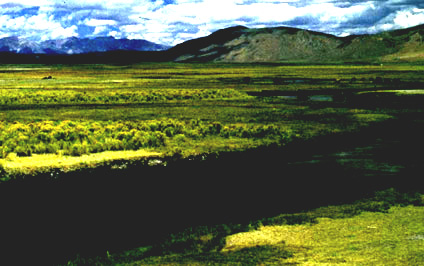 The Owens River, in Mono County.
The Owens River, in Mono County.Bureau of Reclamation had a model irrigated agricultural project for the Owens Valley and had withdrawn or set aside all public lands to keep water for the rural development project.
Fred Eaton, meanwhile was buying up private land in the Owens valley to secure riparian rights.
Joseph B. Lippincott, Bureau of Reclamation Engineer secretly sides with Eaton (personal friends) and his main client was City of Los Angeles despite his work for the Bureau of Reclamation.
p. 146
The City, Eaton, and Lippincott worked secretly to inform each other and acquire lands. Eaton all along had hoped to own the only reservoir site in the Valley and then lease it to the City for twice its value. The city was in no position to turn him down since the Bureau of Reclamation required that the OV project be a wholly municipal project.
Oct. 29, 1905, the Municipal Board felt the project secured.
The Los Angeles Times (with monetary interest in the project) ran the headline "TITANIC PROJECT TO GIVE CITY A RIVER."
p. 150-151
An Aqueduct for the future
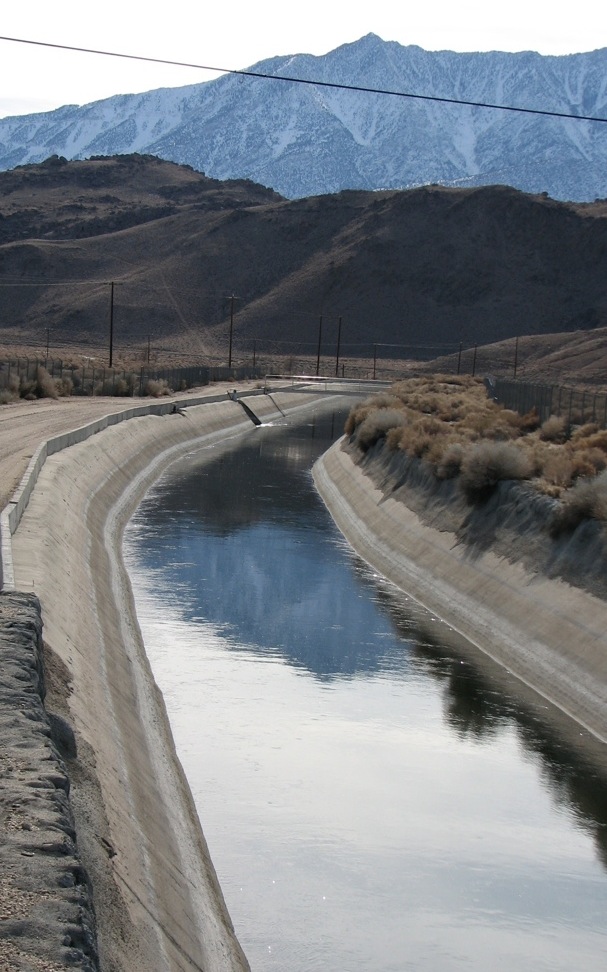 The Owens' Valley aqueduct is owned by the City of Los Angeles, Department of Water and Power.
The Owens' Valley aqueduct is owned by the City of Los Angeles, Department of Water and Power.$25 million needed for the project and federal permission to cross national lands
Bond issues passed in 1905 and 1907 to pay for the land purchases and the building of the aqueducts.
Theodore Roosevelt championed the Owens Valley \ Los Angeles Aqueduct.
Construction began in 1908 and on "November 5, 1913, the first Owens river water poured into the San Fernando Valley.
p. 155
"There it is, Take it" William Mulholland of the water on the dedication day.
p. 156
Corruption of Moses Sherman and the syndicate, the San Fernando Mission Land Company
 San Fernando Valley in Southern California.
San Fernando Valley in Southern California.
The suburban sprawl seen here was based on the newly acquired water.
The benficiearies of the water deal by Mulholland: (Harriman, Huntington, Otis and Edwin J. Earl)
p. 161
Mary Austin and her husband Stafford were among Inyo County leaders who tried to change Washington's mind on the Owens Valley Bureau of Reclamation service project.
 Mary Austin's home in Lone Pine, California.
Mary Austin's home in Lone Pine, California."Believing themselves abandoned by the President, betrayed by the Reclamation Service, misled by Los Angeles, Owens Valley residents remained deeply embittered."
p. 163
1927, the dynamiting of the aqueduct by disgruntled Valley vigilantes.
p. 165
San Francisco: An instant city with an Instant Water Problem
Surrounded by salt water, 20 inches of rain annually.
By 1874 San Francisco had moved from private to a municipal water system with State legislative approval.
p. 173
Hetch Hetchy Valley in Yosemite National Park
Chapter 5
Hydraulic Society Triumphant: The Great Projects
"The spectacular success of Los Angeles and San Francisco excited
admiration and much envy among federal and state engineers whose own water schemes
by the 1920s had produced meager results if not outright failure."
Imperial Valley Impulse
The Colorado River Compact
New Players and New Battles
Compromises and Enactment
Imperial Valley and the Betrayal of the Reclamation Law
New Water and Accelerated Urbanization
The Central Valley Project
Progressive Era Promise and Disappointment
Toward a State Plan
From State to Federal Project
A Project at Last
Battle over Acreage Limitation
"Technical Compliance": A Bipartisan Legacy
Public versus Private Power
The State Water Project
A State Plan
New Water, Growth and Inequities
The Boulder Canyon Project
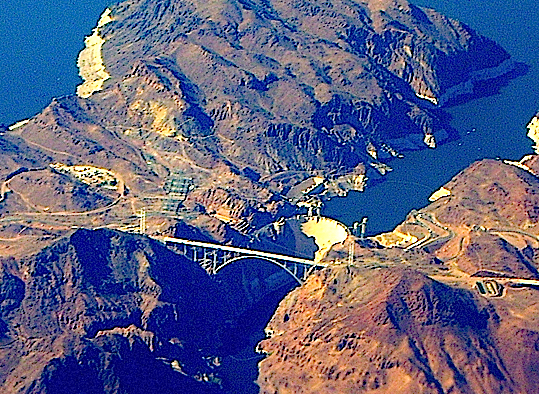
"The term Boulder Canyon Project masks a multidimensional undertaking that had a deep impact on the state, the West, the entire country, and northwestern Mexico. Its origin can be traced to the turn of the century and to the merging of two forceful ideas.
1. The first belonged to Arthur Powell Davis, nephew of John Wesley Powell, the prominent nineteenth century geologist who had unsuccessfully urged the federal government to reform land and water laws and who had gained wide public fame as the one armed explorer who in 1869 had led the first expedition down the Colorado River and through the Grand Canyon. Arthur Davis had grown to manhood inspired by his uncles exploits and the West's rugged beauty.... His attention immediately focused on the Colorado River, the site of his uncle's greatest feats and now, he believed, the means for achievements of his own."
p. 205.
2. Was response to disaster: "struck in 1905. During the previous year the private company delivering the water, without consulting Chaffey who had by then severed his connection with the firm, opened a new intake on the Colorado River.... A surge of high water tore out the flimsy diversion works and soon the entire Colorado River was pouring through a break a mile wide and sweeping back northwestward into the valley, destroying buildings, drowning crops, and transforming the nearby Salton Sink into the Salton Sea."
Colorado River in the Grand Canyon gorge.
"Evidence of something different in the Bureau's values was reflected in its relationship with the Imperial Valley following the passage of the Boulder Canyon legislation."
"That water, provided at subsidized rates (no interest was levied on the federal funds expended for constructing the delivery system), stabilized the valley's irrigable area at about 440,000 acres and brought a measure of security and prosperity unknown before. It also helped fasten a landed elite onto the area."
p, 223.
"Another strong incentive for developing new farmland in the 1960s came from the federal tax code. It allowed investors to deduct as business expenses their development costs this prompting them to rush new fields into production as soon as the water became available. In Kern County, they concentrated at first on such specialty crops as almonds and citrus which grew especially well along the valley's west side. Then when the Internal Revenue Service, under heavy criticism for providing tax subsidies to the wealthy, ended the tax break for citrus and almond orchards in 1969 and 1970, investors poured their money into grapes, olives, and pistachios. The result was glutted markets and nose-diving prices that devastated many of the state's small growers."
pp, 229-230.
"The advocates of California's great hydraulic projects cared little about agricultural working conditions and less about studies pointing out the nature, extent, and inequities of subsidized water for farmers."
![Irrigated agriculture]](Colorado-River-agric_USE-SM.jpg) Irrigated farmland along the California and Arizona borders on the Colorado River.
Irrigated farmland along the California and Arizona borders on the Colorado River.In 1963, California became the nation's most populous state with over 18 million people.
p. 301
Chapter 6
Hydraulic Society on the Defensive
"The years immediately following the inauguration
of the State Water Project brought unprecedented challenges to California's
numerous hydraulic planners."
" Those who traditionally looked upon cheap and abundant water as a birthright reacted with alarm but not resignation as they grappled with environmental militants and devised strategies to slow, if not undermine altogether, threats to the old order."
p. 304.
Arizona vs. California
1963, Supreme Court decision to share the Colorado River water.
longest most expensive and most contested case in USSC history, 11 years, 240 witnesses, 50 lawyers
The Environmental Movement
Peripheral Canal
Round One
Round Two
The Pueblo Water Rights Challenged
Mono Lake and the Public Trust Doctrine
Owens Valley War: Renewed and Cooled But not over
The Fight for the Right to Instream Use
An Increasingly Vulnerable Southland
Chapter 7
Water Policy at the Crossroads
"The setbacks to California's water seekers during the last three
decades did not break their spirit or prevent some telling victories on behalf
of the old cause. Similarly, the resistance of state as well as national voters
to massive new projects because of soaring costs and intense opposition by environmentalists
has not ushered in an era of reform as many had hoped and some even predicted."
" the struggle to preserve an awesomely beautiful and rugged stretch of the Stanislaus River, a stream that rises in the High Sierra north of Yosemite before eventually joining the San Joaquin River west of Modesto."
Tradition vs. Reform: The fate of the Stanislaus River
New and old Challenges to Dams and Levees
The Impermanence of Dams
Los Angeles: A Vexing Lesson
Vulnerable Levees and the Delta
Environmental Crisis: Bay, Delta and CALFED
Environmental Crisis: The Central Valley
Environmental Crisis: Southern California
Subsidized Agriculture and Social Inequity
Water Marketing: Hope, Threat, and Challenge
The Imperial Valley, MWD, San Diego and the Market
The Wheeling rate war: MWD and San Diego
The Governor Intercedes
On War down, Another to go.
The Central Valley Project, "Reform," and the Market
The MWD, the San Joaquin Valley, and the Market
The Quest for Security and Equity
Open Spaces and Farmland: Going, Going, …
A Confusion of Laws
Calls for Reform, Fanciful and Otherwise
Environmental Crisis: Southern California
"polluted water, salinity, the Imperial Valley has been especially hard hits."
"Wetlands, a resource vital to flood control, water quality and species survival by providing wildlife habitat and breeding grounds."
p. 459
Radioactive Contamination of the river water from a site 750 feet from the Colorado River in Moab Utah.
10.5 million tons of uranium
NRC was to cover the 110 foot pile, as had been done in Denver to little or no effect!
pp. 442-443
"Over pumping has eliminated all but a handful of springs on the coastal plain and invited devastating salt water intrusion (first observed in the 1920s.).
p. 444
By the 1980s in Southern California, one of three homes was using bottled water as the principle source of drinking water as compared with one in seventeen in the US as a whole."
p. 460
Subsidized Agriculture
"Just as problems of pollution have persisted, indeed, intensified, in recent years, so, too, has the resilience of agribusiness."
"highly subsidized water" users persuaded the Reagan Administration to change the reclamation law.
p. 461
Open Spaces and Farmland: Going, Going, …
Water "allotment would be reduced to meet actual supplies." Monterey Agreement of 1994.
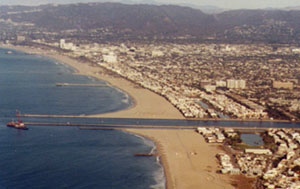 Once orchard and farmland, the Santa Monica Mountains now overlook suburban sprawl.
Once orchard and farmland, the Santa Monica Mountains now overlook suburban sprawl.Chaotic Management
"water management systems that are egregiously localized" and in that sense "it exhibits the centrifugal, fractional tendencies of the American federal system carried to some kind of logical extreme."
Despite James Madison's approach to deter factions,
"The question now in water matters, is whether government is so hobbled and confused that, as a total complex of institutions, it cannot provide reasonable supervision and guidance at all."
p. 534
"Statewide, there is no coordinating authority or management program, there is no one in charge."
Unlike the Pacific Northwest
p. 535
"The need for cooperative water management extends well beyond California to the entire West and, so far as California is concerned, especially to the states of the Colorado River Basin.
p. 536
Part of the problem is structural.
There is no real means by which to solve watershed - wide problems in a way that all stakeholders are represented and equitable solutions can be proposed.
p. 537.
Calls for Reform, Fanciful and Otherwise
California evokes a romantic and near utopian vision for numerous observers.
Transcendentalists, and communal-utopian theorists of the Age of Jackson
critical of Donald Worster, Peter Berg and Raymond Dasmann, as not realistic, wishful thinking.
p. 538
"This vision has a certain appeal, but seems out of touch with modern urban society and a world (increasingly by some 250,000 people daily or 90 million annually) where production only for local; needs -- even if limited to California and the West -- appears a practical impossibility if not undesirable."
p. 539
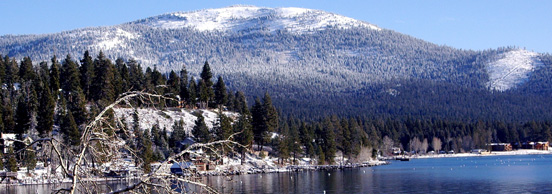 Lake Tahoe in winter.
Lake Tahoe in winter."The fate of all bodies of water is intertwined with human values about the quality of life and the number of people any part of the world can properly support. Closer to home, the message to Californians is the folly of continuing to encourage the influx of people, whether new residents, developers, or farmers, into areas where the environment is already overburdened and despoiled. The message is also about the tragedy of California's rapidly disappearing open spaces and world-renowned farmland through unchecked urbanization and an accelerating market in agricultural water."
p. 542
Chapter 8
Reflections
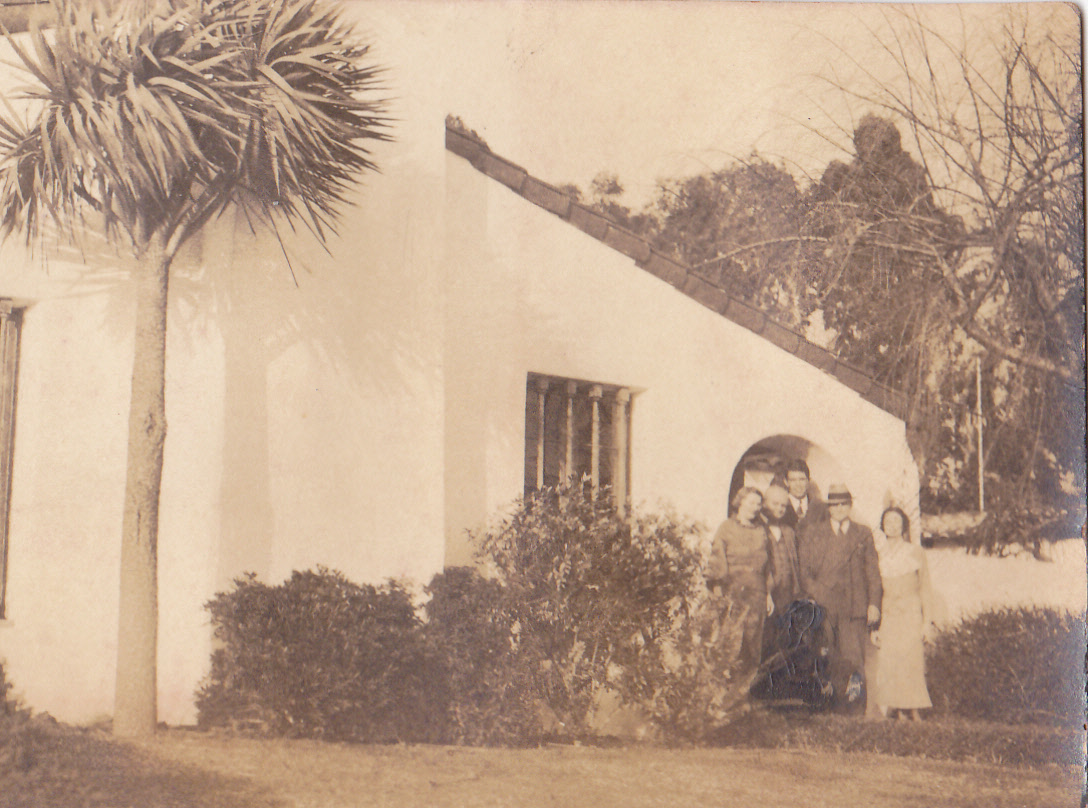
 San Gabriel Valley.
San Gabriel Valley.
"Modern California, with its booming economy (eighth
among the nations of the world if measured separately) and its number
one ranking nationally in population, agriculture, and industry, dominates the
American West and much of the nation like a colossus and exercises great influence
not only in Washington, . . . but also in foreign capitals."
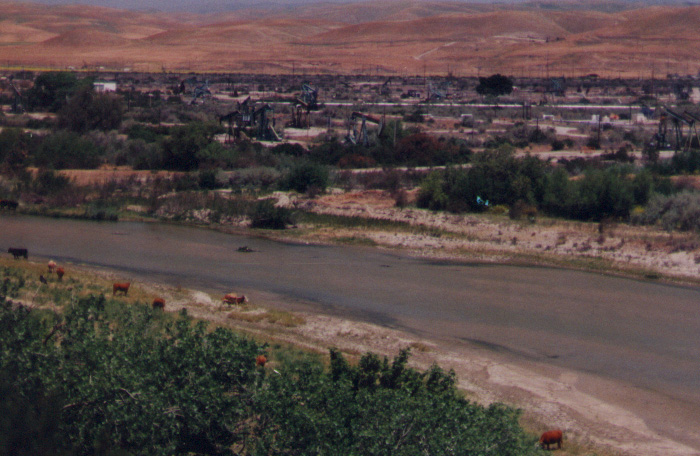 Upper Salinas River Valley.
Upper Salinas River Valley.The water establishment in Calif. has consisted of many competing and often warring groups and is thus not monolithic.
"Water exists to serve humankind."
Perpetual drought conditions,
p. 559.
 Conclusions
Conclusions
"That Californians--and all Americans, for that matter–have abused the land and waterscape and failed to develop a coherent water policy hardly seems surprising for a people with a centuries old tradition of exploitation and with (perhaps illogical) desire to accommodate simultaneously growth, environmental restoration, and at least some wilderness preservation."
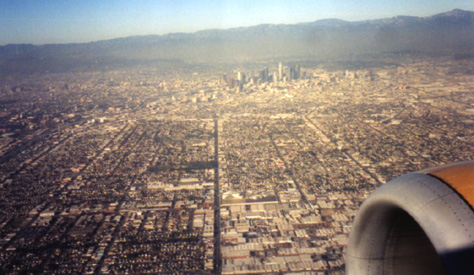 Californians
- "are not so much facing a water problem as a land-use problem."
Californians
- "are not so much facing a water problem as a land-use problem."
"So, too, does the irony of the environmentalists joining with cities in a powerful coalition for water marketing that, without appropriate constraints, could accelerate the urbanization of open spaces and farmland and, withal, the despoliation of a once Golden State."
Los Angeles, shown above at left, is set in a coastal lowland between a coastal range of high hills and a more massive interior mountain range that act as watershed for the city. That is the forested slopes of the surrounding mountains captures rainfall, fog and snowfall to allow water to percolate into the porous sand stone thereby providing underground water sources for the early settlement
Growth of California's three cities:
| Decades: | |||||||||||||||||
| City | 1850 | 1860 | 1870 | 1880 | 1890 | 1900 | 1910 | 1920 | 1930 | 1940 | 1950 | 1960 | 1970 | 1980 | 1990 | 2000 | City |
| San Francisco | 56,802 | 149,473 | 233,959 | 298,997 | 342,782 | 416,912 | 506,676 | 634,394 | 634,536 | 775,357 | 740,316 | 715,674 | 678,974 | 723,959 | 776,733 | San Francisco | |
| Los Angeles | 1,610 | 4,385 | 5,728 | 11,183 | 50,395 | 102,479 | 319,198 | 576,673 | 1,238,048 | 1,504,277 | 1,970,358 | 2,479,015 | 2,811,801 | 2,968,579 | 3,485,398 | 3,694,820 | Los Angeles |
| San Diego | 731 | 2,300 | 2,637 | 16,159 | 17,700 | 39,578 | 74,361 | 147,995 | 203,341 | 334,387 | 573,224 | 697,027 | 875,538 | 1,110,549 | 1,223,400 | San Diego | |
| Total | 61,918 | 157,501 | 247,779 | 365,551 | 462,961 | 775,688 | 1,157,710 | 2,020,437 | 2,342,154 | 3,080,102 | 3,792,555 | 4,224,502 | 4,523,091 | 5,319,906 | 5,694,953 | ||
People need water.
p. 562
| Themes | Contents | Chronology | Conclusions | Map | Water Law
Terms used in Marshes of the Ocean Shore